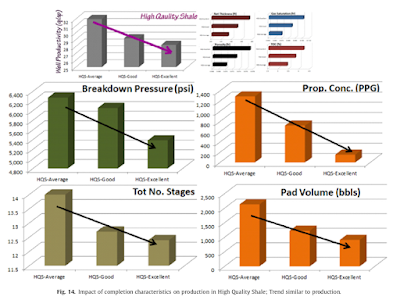Today,
I read the paper ‘Determining the main drivers in hydrocarbon production from
shale using advanced data-driven analytics-A case study in Marcellus shale’.
Summary
Results
of this study show that completion practices that results in good production in
low quality shale are not necessarily just as good for higher quality shale.
When it comes to completion practices in shale, ‘one-size-fit-all’ is a poor prescription.
Pattern
recognition technology is important for designing parameters in shale wells
productivity and distinguishing the impact of parameters that control rock
quality and completion practices.
One plot of Net Pay Thickness versus Gas saturation is shown as follows:
The figure of 2 and 3 categories are shown below:
The
general completion design is more significant in wells completed in High
Quality Shale (HQS) than it is in wells completed in Low Quality Shale (LQS).
HQS is a more prolific reservoir than LQS.
In
both low and high quality shale, it is better to have more number of stages.
(MCF:
million cubic feet)
The granularity is increased from 3 to 6 categories.
Regardless
of the rock quality, it is better to start the fracturing jobs with a higher
amount of pad volume.
Formations
with higher values of Net Pay Thickness, Porosity, Hydrocarbon
Saturation, TOC (Total Organic Carbon) should have more hydrocarbon
reserves than formations with lower values of Net Pay Thickness, Porosity,
Hydrocarbon Saturation, TOC (Total Organic Carbon).
Supervised
Fuzzy Cluster Analysis (SFCA)
Fuzzy
Cluster Analysis is a better tool when we try to discover order in the
seemingly chaotic behavior observed in the complex, multi-dimensional data
sets, of which, data from shale is a good representative.
In
this study acceptable trends and patterns are those that hold at least one level
increase in granularity.
The
paper postulates the acceptable minimum number of wells (population) in a
cluster or category to be 8 wells.
Completion analysis of LQS is shown below:
Completion analysis of LHQS is shown below:
In
the LQS, completion does not do much more than allowing the rock to behave in a
matter that is expected of it. However, for the HQS completion and well
construction practices must influence the production such that they overshadow the
influence of reservoir characteristics.
The
objective of this paper is to introduce a novel, advanced data driven analytics
technology that makes sense of complexities of production from shale wells.
Advanced
Data-Driven Analytics is capable of using facts (field measurements) to help optimize
production form shale.
Tomorrow,
I will read more papers on ANN.









How many papers did you read today? You should try to read two.
ReplyDeleteFocus more on the method and less on the results.
Have a ppt or a document where you can put all the methods and software that can help you in your research.
Thank you so much for your reminder. I will read faster and focus more on the method and less on the results.
DeleteThank you so much for your reminder. I will read faster and focus more on the method and less on the results.
Delete